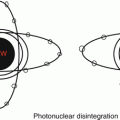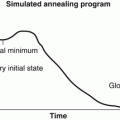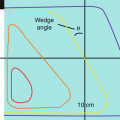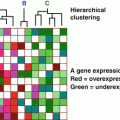, Foster D. Lasley2, Indra J. Das2, Marc S. Mendonca2 and Joseph R. Dynlacht2
(1)
Department of Radiation Oncology, CHRISTUS St. Patrick Regional Cancer Center, Lake Charles, LA, USA
(2)
Department of Radiation Oncology, Indiana University School of Medicine, Indianapolis, IN, USA
Deterministic and Stochastic Effects
A deterministic (non-random) effect occurs after exceeding a threshold dose, and the severity of the effect correlates with the dose.
For example, radiation induced skin erythema.
A stochastic (random) effect occurs randomly with a probability that is proportional to dose, and the severity of the effect is random.
Both secondary malignancies and heritable mutations are stochastic effects.
Equivalent Dose and Effective Dose
Absorbed dose is measured in Gy, but this does not take into account the type of radiation, or the type or volume of tissue irradiated.
For radiation safety purposes, dose is multiplied by a weighting factor (WF) that corrects for the type of radiation.
This number is known as equivalent dose and is measured in Sieverts (Sv).
WF varies with type of radiation:
Photons and electrons, WF = 1.
Protons, WF = 2.
Neutrons, WF varies, up to 20.
Heavy ions, WF = 20.
In addition, partial-body exposures can be multiplied by a tissue weighting factor (W T ) to obtain an effective dose.
Effective dose is also measured in Sv but depends upon the volume of tissue irradiated.
So let us say a chest X-ray gives 0.5 mGy to the chest:
The equivalent dose is 0.5 mSv to the chest.
The effective dose is closer to 0.1 mSv (approximately – the real number actually depends on male vs. female, due to breasts).
Dose Response for Radiation-Induced Cancers
The linear no threshold (LNT) model assumes a direct linear relationship between dose and carcinogenesis.
This is in contrast to dose–response models that have a threshold beneath which radiation carcinogenesis does not occur.
Radiation hormesis models hypothesize that extremely low doses of radiation may actually be beneficial (Fig. 31.1).
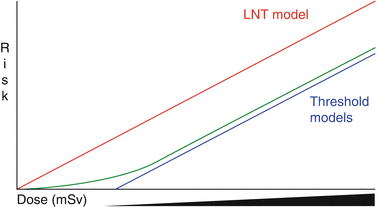
Fig. 31.1
Cancer risk to dose models including linear no threshold model (red) and linear threshold models (blue). The true cancer risk from low doses of radiation may more closely resemble the shape of the green curve.
The current human evidence is insufficient to either prove or disprove the existence of a threshold.
The LNT model is the most conservative approach, so it is used for radiation protection purposes.
Mechanism for Carcinogenesis
Ionizing radiation causes double strand breaks, leading to chromosomal aberrations, mutations, and genomic instability.
Aberrations may be lethal, or may be permanently passed on to cellular progeny.
Cells that survive radiation with aberrations and genomic instability are believed to be involved in radiation –induced carcinogenesis.
Radiation-induced mutations are typically large-scale deletions, duplications, translocations, chromosomal aberrations or aneuploidy.
Radiation can also cause point mutations (single nucleotide polymorphisms, transitions, transversions, frameshifts, micro-deletions or insertions).
These are more characteristic of random (sporadic) and chemical induced mutations.
Radiation Protection Organizations
The Biological Effects of Ionizing Radiation (BEIR) is an academic committee devoted to the basic science behind radiation protection.
The United Nations Scientific Committee on the Effects of Atomic Radiation (UNSCEAR) is a reporting and regulatory agency.
The International Commission on Radiation Protection (ICRP) is an advisory agency.
The National Council on Radiation Protection and Measurements (NCRP) is a US council that publishes reports and recommendations.
The only consistent human data for long-term effects of radiation exposure are the Japanese atomic bomb survivors.
Absolute and Relative Risk of Carcinogenesis
Approximately 40 % of all humans will suffer a malignancy at some point in their lifetime.
For the vast majority of people exposed to radiation, the absolute risk of a radiation-induced malignancy is much smaller than the absolute risk of sporadic malignancies.
The BEIR and ICRP models of radiation carcinogenesis assume that radiation is a relative modifier of malignancy.
That is, radiation multiplies the frequency of malignancy by a dose- and age- dependent factor.
This model implies that radiation-induced malignancies are likely to have an age- and site- distribution similar to sporadic malignancies, whether or not that is true.
Radiation and Chemotherapy Carcinogenesis
Chemotherapy drugs are known to cause second malignancies, most prominently leukemia risk with alkylating agents.
The latency of secondary leukemias is significantly shorter (few years) than solid tumors (decades).
Combined chemotherapy and radiotherapy is likely to increase secondary malignancy risk.
Stay updated, free articles. Join our Telegram channel

Full access? Get Clinical Tree


